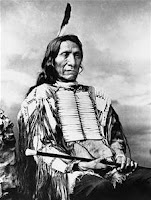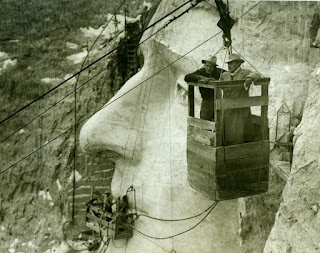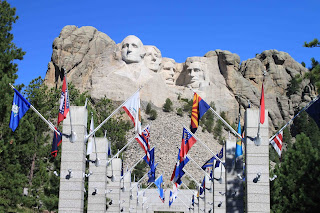Market for Elephants- Bad Winter is too hard, summer to dry.
Date of my Visit- August 13, 2015
Geology:
Date of my Visit- August 13, 2015
Geology:
The Black Hills are one of three isolated mountain ranges in South Dakota, Montana and Wyoming all of which are believed to have been produced about the same time by the same unknown forces.
The Black Hills rose from a vast plain covered with a thick layer of
sediments, much of which have eroded away. The central ridge now consists primarily of granite, with intrusions of quartz, feldspar, and mica called Harney Peak granite, after the highest peak in the range.
History:
There is evidence that the Black Hills were inhabited as far back as eleven thousand B.C. In historic times several Native American tribes contested over the valuable area.
Surrounded by arid prairies the mountains were valuable sources of water, shelter in the winter, and supplies of wood. In the Black Hills the Native Americans found fish, plants like ground plums, box elder trees whose sap provided sugar, and various herbs. They were referred to by one resident, Sitting Bull, as “the food pack of the people.”
When the white Americans first turned their attention seriously to the hills in the 1800s the area was mainly under the control of the Lakota (also known as the Sioux) and their occasional allies the Cheyenne. The name
Black Hills comes from the Lakota phrase Paha Sapa referring to how the forested hills look black from the plaines. Anyone who has approached from I-90 will understand this phrase.
The Lakota seem to have had a strong spiritual bond to the hills before the majority of them moved to the area. Their creation myths say that the first humans originated deep within the earth and came to the surface through the now famous Wind Cave. The bison, center of much of the plaines’ culture, also emerged from the cave on the same day.
Circling the Black Hills is the Red Valley a broad valley eroded from soft sedimentary rock, which gets its color from red siltstone. This was known to the Lakota and early white settlers as the racetrack.
The Thunder Beings, the powerful beings responsible for the thunder storms the mountains are prone to, informed Chief Red Thunder there was to be a race between the two-legged (the birds) and the four-legged (mammals). If the two-legged won, the Lakota would live and spread over the mountains. But if the four-legged won, they would eat the two-legged, including all the humans.
When the race started, a magpie hid right near a buffalo’s ear, and sat there while the animals raced. The race lasted for days. One day it was so windy the birds couldn’t fly, but another day was so hot the animals couldn’t run. Near the finish the buffalo was in the lead, so the magpie took off. Weak from hunger, the magpie couldn’t stay in the air long but he fell to earth just across the finish line, winning.
The Thunder Beings rewarded the magpie with a rainbow and gave Red Thunder the bow and arrow, making the people able to defend themselves and hunt large game. The race track was worn by this contest.
The Lakota’s and Northern Cheyenne’s first permanent contact with whites was trading for buffalo skins in the 1800’s. The hides were used not only for fashionable robes but drive belts for machinery.
Later the famous Oregon Trail passed thru Lakota territory south of the Black Hills. In 1841 when one of the first wagon trains reached the Platte it seemed to be a curiosity to the natives. A man named Dawson, who had been out hunting. rushed back without his rifle, pistol, mule and most of his clothing. He insisted thousands of Indians had surrounded and robbed him. The wagons quickly circled and fortified themselves.
A party of forty Cheyenne arrived that evening. Two leaders came to the camp to return Dawson’s rifle and mule explaining Dawson was so scared when he saw them they had to disarm him. As he ran away he threw away his pistol and clothes, which they could not find. For the rest of his life the excitable hunter was called “Cheyenne” Dawson.
However by 1845 approximately 2500 settlers used the Oregon Trail and the numbers increased almost every year. Fortunately only a few wished to settle in the semi-arid area. However they changed the buffalo’s normal migration by grazing a “trail’ a dozen or more miles wide and scared away game.
More basically the Lakota felt that they deserved something for having people pass thru their territory. The whites saw the plains as “unoccupied” American land and the Lakota’s occasional demands for “gifts”, (coffee, sugar, and livestock) totally unjustified.
Tragically the winters of 1849 and 1850 brought cholera and small pox. One Lakota subtribe, the Brule’s, lost five hundred of their thirty-five hundred people. They not only understood the diseases were spread by the whites, but suspected it was being done deliberately.
Demands for protection from the Native Americans caused the establishment of an army base Fort Laramie in 1849 on the North Platte River. Government agents managed to arrange a massive meeting of numerous tribes and negotiated a treaty in 1851 which acknowledged the Lakota claims to an area the size of Oregon and promised regular compensation for the next fifty years for the damage done by travelers.
However the compensation was cut by Congress and limited to ten years. Washington demanded a single chief be named for future negotiations. In the plaines culture chiefs were not formally elected. They were someone who thru status, usually earned as a warrior, was allowed to speak for their particular group, as long as they did their job well. Since Indians couldn’t agree on a paramount chief the Americans named one, a Lakota named Brave Bear. He and other leaders hoped to negotiate future problems both to avoid bloodshed and keep the annuities coming.
The agreements broke down in 1853. The commander of Fort Laramie refused to allow a Lakota to compensate a settler for killing his ox and tried to arrest him. This ended in a pitched battle with the entire twenty-nine man Army patrol killed. It is unknown how many Lakota died but one was Brave Bear.
The next year General William S. Harney was sent with six hundred soldiers to punish the tribes. He surprised a camp from the group that had killed the soldiers. He killed at least sixty-five, half of whom were women and children and took about seventy women and children prisoners. It was about this time Harney Peak was named for him.
The tribes met and agreed those that chose to could continue to accept government annuities. The militant leaders, especially Sitting Bull a respected spiritual leader, opposed any negotiations and pressed everyone to block all travelers especially from the Black Hills. Most decided to leave the emigrant trains alone. They all agreed anyone who revealed the presence of gold in hills would be executed. It is unclear who identified the gold to them. However travelers to gold strikes had already opened two routes thru Lakota territory so they understood its value.
From 1861 to 1865 because of the civil war the tribes had more people entering their territory and fewer soldiers to protect them than ever before. A major part of the Lakota confederation however simply stayed in their northern territory away from the whites.
The Northern Cheyenne however raided freely while easily evading the troops. Half Cheyenne George Bent reported he had never seen them so rich with loot.
Attempts to form militias ended in ignorant whites killing neutral natives. The situation reached its peak in 1864 when Colonel John M. Chivington promised safety to a band of Cheyenne if they would move to Sand Creek, Colorado. Chivington then attacked and killed about one hundred and thirty Cheyenne mostly women and children. A war pipe was passed to the other tribes, but the Northern Lakota did not join as a group, another example of their individualistic culture blocking group action.
After the Civil war in 1866 a meeting was called by U.S. agents and attended by several chiefs. However when the Lakota realized that eight new forts were to be built along all the trails full scale irregular warfare broke out again.
Led by Red Cloud and Sitting Bull attacks were made on some of the forts and all travelers, civilian and military were harassed. Their greatest success was at Fort Philip Kearney. Red Cloud led a loose siege of the fort and
blockade of the main road. From early August to mid-December 1866— the Indians killed 154 soldiers and travelers, wounded 20 more, and captured nearly 700 horses and cattle. Finally a carefully organized ambush by almost fifteen hundred Lakota, Cheyenne, and Arapaho destroyed an entire unit of eighty one men just out of sight of the fort.
The U.S. army wanted vengeance. This was delayed by the reduction to army funding at the end of the civil war, and the decision to concentrate on protecting the transcontinental railroad.
In 1868 moderate leaders including Spotted Tail and even war leader Red Cloud reached agreement on another treaty which promised land to be set aside for a Lakota nation, which included the Black Hills. Most of the forts were to be removed.
In 1870 Red Cloud tried to negotiate moving the Indian agencies closer to the Black Hills, so the tribes could use the “food locker” and also pick up government allotments. He traveled to Washington to meet with the
 |
| The treaty room in the White House designed to impress Indians |
These negotiations revealed to him the Lakota leaders, who could not read, had each been told different things about the 1868 treaty, and none understood they were granting lands to the United States and had promised to send their children to white run schools.
In 1873 General Philip Sheridan recommended a strong military force be sent to survey the Black Hills. They would find a point for strong fort in the center of the Lakota nation and spread the news if conditions would draw settlers. This Sheridan probably hoped could bring on a final conflict.
The massive 1874 Custer expedition consisted of nine hundred soldiers, several scouts, journalists, and a few serious scientists. Lt. Colonel Custer was met by a Lakota delegation that reminded him whites were barred from the hills. He produced a copy of the 1868 treaty showing the government was able to send agents anywhere in the treaty area.
Custer published glowing reports of the Black Hill’s water supply, timber, and gold. Prospectors began rushing into the area. The Army was assigned to keep whites out of the Hills but found this so difficult General Crook made a deal. If the prospectors left, any claims they registered would be honored when the area was opened to settlement.
That the U.S. could purchase the Black Hills seemed possible. Some tribes had found the buffalo herds were so depleted by commercial hide hunters that they needed the government allotments, as meager as they were, to avoid starvation.
Another meeting with a government commission took place on the White River in 1875. The Lakota leaders Spotted Bear and Spotted Tail tried to negotiate a price which would allow all their people to live on interest for a
 |
| Lakota encampment |
The government commission didn’t offer anything near the suggested prices and the Lakota now knew that Congress might change the terms of any agreement. Then medicine man Sitting Bull sent three hundred men, under Little Big Man, with the message that he was declaring war on all white men. His messengers also threaten to kill any Native Americans who supported selling.
With the failure of negotiations the non-treaty tribes launched unrestrained attacks on miners. President Grant ordered all tribes to report to their agencies or face starvation. While some of the tribes that had signed treaties came in, none of the non-treaty tribes left their lands.
In the summer of 1876 three large armies moved against the non-treaty tribes hoping to trap the hostiles between them. This campaign ended in several small defeats for the Americans and one disaster. Custer and two
hundred and eighty one men were killed.
The death of the popular war hero angered all of America. He was shown as a martyr to the civilization of the Indians. Congress ruled that the Lakota must give up all claims to the Black Hills.
 |
| Custer's Last Stand |
The tribes already living at the agencies had no choice but to give in. They were under the threat of starvation, possible involuntary transport to the Oklahoma Indian territory, and direct military punishment.
The non-treaty tribes picked up some new recruits after their victory, but because they were dependent on hunting had to break into smaller groups. Their mobility let them avoid the Army but could not gather the manpower and supplies to attack. Some like Sitting Bull went to Canada.
 |
| Sitting Bull |
Finally General Crook made unauthorized promises to the Lakotas and Cheyennes, telling them that they could surrender at the agencies. Eventually even Sitting Bull settled on a reservation.
This basically ended the military part of the story. However the natives have never ceased to seek either restitution or return of their land thru the legal system and social pressure.
For almost a century claims for restitution were filed with and rejected by the U.S. Court of Claims, Federal Courts, Supreme Court and, after it was formed the Indian Claims Court. Finally in 1974 the ICC reviewed its two earlier decisions and awarded a Lakota and Dakota alliance $17 million for the seizing of the Black Hills without proper restitution. When the Justice Department appealed to the Court of Claims the award was raise to $102 million. The Supreme Court supported this decision in 1980.
Then in an incredible twist the claimants refused monetary restitution and insisted on the return of the Black Hills. The activism of the 60's and 70's had spread to demanding the tools to maintain the claimants as a people. Activities since then include further law suits and attempts to have special federal legislature. In January 2016 Representative Sean Bordeaux introduced a bill in the South Dakota legislature calling for the federal government to return select lands in the Black Hills.
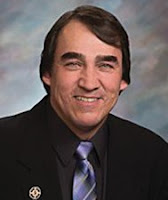 |
| Sean Bordeaux |
To quote Representative Bordeaux “Many of the leadership in the committee had not been aware of the Treaty of 1868... It gave me a chance to educate them and give them information about what is in the treaty and what the tribes expect based on promises made when the treaty was signed. I told them that I too learned about how Columbus discovered America and that I had to learn about the treaty at home. The bill was defeated but was a good start to a lifelong lesson that will bring about better understanding between the people.”
Between 1876 and 1935, the value of gold taken from the Hills totaled $358 million according to estimates used to calculate the Lakota’s restitution. For the first 15 years most of the gold from the hills was found in placer deposits where eroded gold heavier than most sand particles settle in stream beds.
Two small towns developed to serve the miners, Custer and Keystone. A small gage rail road ran to Keystone to carry ore.
However placer deposits give out and small mines proved too expensive to operate. The gold veins were thin and twisting and the gold had to be separated from other rocks with cyanide processes. This has led to contamination and years of protests and legal battles.
The primary mine from the beginning is the still operating Homestead Mine which produces Dore, a mixture of gold and silver.
Mt. Rushmore:
About 1924 Doane Robinson, Poet Laureate of South Dakota and Peter Norbert, U.S. Senator from South Dakota, were looking to boost tourism in their state. An idea they focused on was to have western heroes carved on the Black Hills.
They knew a world famous sculptor, Gutzon Borglum, was carving a
 |
| Stone Mountain |
 |
| A Borglum Cowboy |
During a fishing trip in 1925 the artist studied different mountains and chose Mr. Rushmore for its clean stone wall. He had the site examined by a geologist who agreed the sheet of granite over sedimentary rock could be shaped safely.
The mountain got its name about 1900 when Charles Rushmore, a young
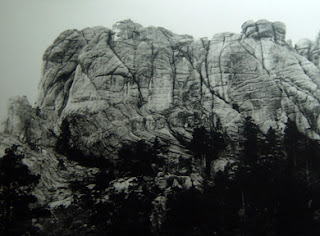 |
| Rushmore before the sculpture |
Senator Norbert knew congress was debating funding eastern and western monuments to Theodore Roosevelt and thought they should try for that. Borglum dreamed bigger and in a letter to the senator said “The portraits should be of Washington and Lincoln, the founder and savior…portraits of Jefferson, who is the first great expansionist and Roosevelt who completed commercial control by securing the Panama Canal.”
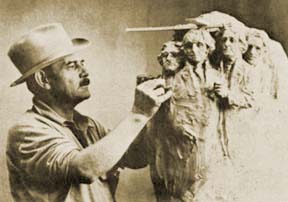 |
| Gutzon Borglum |
Despite a 1925 dedication work did not begin in earnest until 1927 when John Boland, a Rapid City business man, raised sufficient donations to set up workshops and purchase equipment. Then they had to stop from the winter of 1927 till 1929.
Boland, Norbert and others worked to raise funds by every means even school children’s donations. Borglum traveled and lectured for large fees. He even used some of his own funds earned on other projects he did at the same time like the North Carolina memorial for Gettysburg and statues for the Congressional building.
In 1929 just before leaving office President Calvin Coolidge signed into law a bill that placed control of the project in a thirteen man federal commission.
Even with John Boland as the first chairman and Norbert as a member money emerged slowly from the commission even as work intensified.
First the rough shaping was done with dynamite. Borglum never said for certain but his initial plan for Jefferson to be to the left of Washington may have been changed because too much rock was dynamited away. Many of his workers were hard rock miners used to thinking in tonnage.
Once the area had been shaped, a protractor system was used to transfer a
grid of dots from the 1 to 12 size model Borglum had prepared to the rock surface. One inch on the model was a foot on the cliff. The dots were drilled out to carefully set depths with jack hammers, powered by air hoses linked to a compressor on the top of the hill.
Then the space between the holes was chipped away by hand with hammers and chisels. Finally a pneumatic drill and special bit was used to smooth the rock.
This was all done by men hanging in harnesses off a tall mountain.
The safety record seems very good for using equipment and techniques developed by trial and error. With four hundred men having been employed
over the years the most serious injury was when the main shaft in the host house broke and the tram car bringing three men down slide at high speed along the cable. The tram was stopped before crashing but one man tried to jump to safety and spent several weeks in a hospital, with Borglum visiting him regularly
In 1933, the National Park Service took Mount Rushmore under its jurisdiction and at least some of the problems with continued funding ended. On July 4, 1934, Washington's face was dedicated. The face of Thomas Jefferson was dedicated in 1936, the face of Abraham Lincoln on September 17, 1937 and the face of Theodore Roosevelt In 1939.
In 1938 Borglum had become worried the identities of the statues might be lost. He was cutting a cave for a hall of records when in 1940 the project was declared finished by Congress.
In 1998 the park service installed a titanium door on the hall. This repository now contains sixteen porcelain enamel panels, inscribed with the story of the statues, and a brief history of the United States. It is intended for visitors in the future and is not open to visitors now.
My Visit:
Like most folks I entered the Black Hills by Rt. 16, (Mount Rushmore Rd.) from Rapid City. I recommend spending two nights in Rapid City.
Its 23 miles to Rushmore, the road is fine, except in the town of Keystone where it is usually crowded. There are also tourist stops, a reptile center, a duplication of Constitution Hall, and several rock shops along the road before entering the park. Ignore them.
There is no charge for the statute park proper, but you do have to pay for parking. Climbing out the gigantic parking lot you first enter a flag display to the Grand View Terrace where you get the Iconic view of the statues. A schedule is available at the information center of ranger programs for that day and the seasonal hours of the lighting program.
I went for the short (.5 mile) Presidential Trail that runs along the base of
Mt. Rushmore. Not too challenging except for 422 steps it gives the opportunity for shots at several angles of the statues. I got into several interesting conversations about whose faces they were and why they were chosen.
At the end of the trail is the Sculptor’s Studio where you can see the statue used to guide the carving, equipment used for cutting and drilling, and hear live fifteen minute lectures.
Up another short trail you are back at the Grand View Terrace. Below it is the Lincoln Borglum Visitor center with numerous displays about the sculptor from beginning to end.
The bookstore is good, but expensive. The snack bar and restaurant are way overpriced. I did enjoy a specialty item, ice cream prepared to Thomas Jefferson’s recipe. It’s thick more like a custard then modern ice cream that has air pumped into it.
Geek Factors: The statues have appeared in too many movies to be mentioned. I was taken back to the climax of North by Northwest- but most of the foreign tourists I spoke to remembered a scene from Richie Rich.
Further Sources:
Oh Ranger:Black Hills, Badlands & Mount Rushmore (OhRanger.com)
Roadside Geology of South Dakota by John Paul Gries :2013, Mountain Press, Mt.
ISBN 978-0-8742-338-5
Six Wars At A Time by Howard Sharr, 1990 The Center for Western Studies, S.D.
ISBN 0931170-26-6
Tales of the Frontier by Everett Dick 1970, The University of Nebraska, Lincoln
ISBN 0-8032-5744-9
Further Sources:
Crazy Horse and Custer: The Parallel Lives of Two American
Warriors by Stephen Ambrose, 2014 Open
Road Media, ASIN: B00KQZY19A
The Lakota and the Black Hills: The Struggle for Sacred
Ground by Jeffrey Ostler, 2011 Penguin Library of America Indian History ISBN-978-0143119203
Oh Ranger:Black Hills, Badlands & Mount Rushmore (OhRanger.com)
Roadside Geology of South Dakota by John Paul Gries :2013, Mountain Press, Mt.
ISBN 978-0-8742-338-5
Six Wars At A Time by Howard Sharr, 1990 The Center for Western Studies, S.D.
ISBN 0931170-26-6
Tales of the Frontier by Everett Dick 1970, The University of Nebraska, Lincoln
ISBN 0-8032-5744-9





